



















|
 |
|
 |

The Koinon Hellenon are, as most Hellenic factions, phalanx-dominant. Their army is usually made up of different phalanx units, as well as skirmishers. They also have cavalry, but which isn't quite up to Successor standards.
Hoplitai Haploi (Greek Levy Hoplites)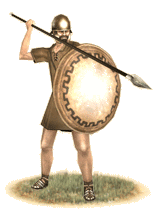 The poorest citizens of the Hellenic and Makedonian poleis fought as a militia roughly organized along the lines of other, more professional hoplite soldiers. They are organized in the phalanx and are quite high quality for militia, due to the dogged Hellenic spirit and fighting tradition. They can be expected to hold a line against most light and medium infantry, though they will be devastated by missile troops, as they have virtually no protection from missiles aside from their shields and the bodies of their compatriots. They are still useful against cavalry as no horse will willingly charge a bristling wall of spear points. Hoplitai Haploi, if used properly, can be an inexpensive and very valuable unit, though they will be outclassed against heavier and more professional troops, they can, if well supported, hold the line far better than one would expect of a militia. The poorest citizens of the Hellenic and Makedonian poleis fought as a militia roughly organized along the lines of other, more professional hoplite soldiers. They are organized in the phalanx and are quite high quality for militia, due to the dogged Hellenic spirit and fighting tradition. They can be expected to hold a line against most light and medium infantry, though they will be devastated by missile troops, as they have virtually no protection from missiles aside from their shields and the bodies of their compatriots. They are still useful against cavalry as no horse will willingly charge a bristling wall of spear points. Hoplitai Haploi, if used properly, can be an inexpensive and very valuable unit, though they will be outclassed against heavier and more professional troops, they can, if well supported, hold the line far better than one would expect of a militia.
Historically, the poorest citizens of any polis and the peasants on the estates of Makedonia were called up in defense of their homeland to fight as militia. They had been used to devastating effect in many ancient battles while forming the second line of battle. They were good and courageous soldiers that fought with a degree of discipline and courage that would not be thought possible of an unprofessional milita. They were not cowards and did not break quickly, but were often annihilated if facing good missile troops or heavier, more professional infantry. Peltastai and other units armed with javelins were particularly devastating to the militia hoplites, due to their lack of protection on the battlefield.
Akontistai (Hellenic Skirmishers)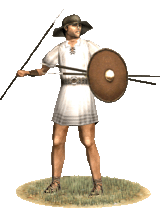 Those unlucky enough to be extremely poor freedmen were pressed into service as psiloi, missile units, and the lowest class of Hellene infantry. The psiloi were divided into three parts: javelineers, slingers, and archers. The javelin-armed psiloi, the akonistai, were ragged peasants armed with javelins and small knives. Their function was simply to throw their missiles and then run as fast as possible to safety behind the hoplitai lines. They were used for skirmishing and to provide a demoralizing hail of missile fire during the grinding battle between the two phalanxes. Never use akonistai in melee except as diversionary fodder or as a flanking force; roles in which they don't excel, but might actually be better than nothing. They have their uses, as their javelins are still sharp and deadly, but they were often used only as light skirmishers or as a last resort in Hellenic armies for obvious reasons. Those unlucky enough to be extremely poor freedmen were pressed into service as psiloi, missile units, and the lowest class of Hellene infantry. The psiloi were divided into three parts: javelineers, slingers, and archers. The javelin-armed psiloi, the akonistai, were ragged peasants armed with javelins and small knives. Their function was simply to throw their missiles and then run as fast as possible to safety behind the hoplitai lines. They were used for skirmishing and to provide a demoralizing hail of missile fire during the grinding battle between the two phalanxes. Never use akonistai in melee except as diversionary fodder or as a flanking force; roles in which they don't excel, but might actually be better than nothing. They have their uses, as their javelins are still sharp and deadly, but they were often used only as light skirmishers or as a last resort in Hellenic armies for obvious reasons.
Historically, akontistai did not play a particularly large role on the battlefield, and weren't normally a particularly decisive force. They were used mainly for their ability to induce an enemy to attack prematurely. They are little more than an annoyance on the open field, but can be deadly if positioned in places where their javelins can be used for maximum effect: on high terrain, on an enemy unit's flank, or atop a city wall.
Sphendonetai (Hellenic Slingers) Sphendonetai are the second branch of the psiloi, and are only marginally more useful than their compatriots with javelins. Their sphendonai (slings) can prove deadly weapons, being able to crush bones and armor, and shatter shields from a distance, but they are mainly used to harass and annoy enemy soldiers to force a premature or rash action. Since a sphendone is an easily constructed weapon, and ammo is readily available in Hellas' rocky terrain, Sphendonetai are mostly poor peasants and shepherds that use this weapon to provide a meager amount of protein in their already poor diet or use their weapons to keep predators away from their flocks. Sphendonetai are the second branch of the psiloi, and are only marginally more useful than their compatriots with javelins. Their sphendonai (slings) can prove deadly weapons, being able to crush bones and armor, and shatter shields from a distance, but they are mainly used to harass and annoy enemy soldiers to force a premature or rash action. Since a sphendone is an easily constructed weapon, and ammo is readily available in Hellas' rocky terrain, Sphendonetai are mostly poor peasants and shepherds that use this weapon to provide a meager amount of protein in their already poor diet or use their weapons to keep predators away from their flocks.
Historically, sphendonetai had their uses, they were often used to harass and provoke the enemy forces by causing some casualties and some damage to the enemy's armament, particularly the shields, which were easily dented or cracked by a well slung glande (sling projectile). Alexandros employed his sphendonetai at the battle of Gaugamela to harass the Persian heavy cavalry until they decided to give fight, and then promptly cut them off from the rest of the Persian army, allowing the Hetairoi to cut them to shreds.
Toxotai (Hellenic Archers)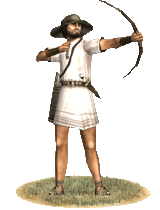 Toxotai are the third branch of the psiloi, the archers of Hellene and Makedonian armies. They are generally from the upper end of the poor and recruited from mountainous regions where the use of the bow is an essential skill to keep one's flock of sheep safe from roving predators. Toxotai are well trained in a manner of speaking, that being that they are using their weapon of choice (often of necessity) from birth. They are decent archers, but are nowhere near as professional as the archers from the east and south. They mostly use the short bow, which means that they are often outgunned by their counterparts from other lands. This reflects their secondary role in a Hellenic army. As most missile units, they will be cut to ribbons in melee, so they should be well protected from enemy ranks. Toxotai are the third branch of the psiloi, the archers of Hellene and Makedonian armies. They are generally from the upper end of the poor and recruited from mountainous regions where the use of the bow is an essential skill to keep one's flock of sheep safe from roving predators. Toxotai are well trained in a manner of speaking, that being that they are using their weapon of choice (often of necessity) from birth. They are decent archers, but are nowhere near as professional as the archers from the east and south. They mostly use the short bow, which means that they are often outgunned by their counterparts from other lands. This reflects their secondary role in a Hellenic army. As most missile units, they will be cut to ribbons in melee, so they should be well protected from enemy ranks.
Historically, the Hellenes did not use archers in any significant fashion. They did not have the composite bows of their neighbors, and their lands were not particularly suited to the cattle and horse farming that supplied the raw material for these bows. Therefore, archers fulfilled the same role as other psiloi: that of long range harassment. The Hellenes and Makedonians had no real tradition of archers and could not recruit any but these shepherds to do this work for them, since they lacked any access to the archers of the east. Most Hellene states relied on Skythian and most importantly Kretan archers to do this for them.
Hippakontistai (Hellenic Skirmisher Cavalry) Hippos Akontistes (literally "javelin horsemen") are the standard among Hellene light cavalry. They are lightly armored, often wearing nothing but padded cloth for protection. The key to their method of warfare is speed, and they are armed accordingly. They ride small, but swift horses and harass enemy infantry and heavy cavalry with javelins. This is their primary use, because their light armor is really a detriment when they are engaged in any kind of melee combat. Their swords and shields are simply no counter to lances or heavier cavalry swords. Hippos Akontistes (literally "javelin horsemen") are the standard among Hellene light cavalry. They are lightly armored, often wearing nothing but padded cloth for protection. The key to their method of warfare is speed, and they are armed accordingly. They ride small, but swift horses and harass enemy infantry and heavy cavalry with javelins. This is their primary use, because their light armor is really a detriment when they are engaged in any kind of melee combat. Their swords and shields are simply no counter to lances or heavier cavalry swords.
Historically, Hellas did not have a great tradition of light cavalry warfare, or indeed of any cavalry warfare. Hippakontistai were much like the Equites of Rome, the spoiled children of the richest families that could afford horses. They were usually not used in any front line capacity other than skirmishing and pursuit, and their equipment reflects this. Makedonian cavalry of the same type operates in a similar fashion, but generally comes from the poorest noble families, those who can afford horses but not the heavy armor required for the heavy cavalry.
Hoplitai (Greek Classical Hoplites)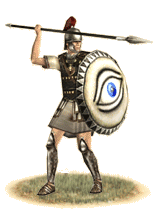 Even though the Makedonian phalangitai has become the dominant infantry type among the Hellenic powers, the hoplitai of old, those who fight in much the same manner as the Hellenes of Thermopylai, Marathon and Plataiai did, are still around defending their poleis. Each hoplites is equipped with linen or leather armor, an aspis shield, greaves, the attic style helmet and of course, his spear. Their equipment might have changed since the battles of a centuries past, but their tactics has not. The hoplitai still fight in the phalanx formation, often eight man deep whose purpose is to advance forward upon the enemy line, tie them and to whittle them down through attrition. Even though the Makedonian phalangitai has become the dominant infantry type among the Hellenic powers, the hoplitai of old, those who fight in much the same manner as the Hellenes of Thermopylai, Marathon and Plataiai did, are still around defending their poleis. Each hoplites is equipped with linen or leather armor, an aspis shield, greaves, the attic style helmet and of course, his spear. Their equipment might have changed since the battles of a centuries past, but their tactics has not. The hoplitai still fight in the phalanx formation, often eight man deep whose purpose is to advance forward upon the enemy line, tie them and to whittle them down through attrition.
Historically, the hoplites is one of the most famous types of soldiers that has ever existed. The Hellenic military ethos and culture from the 8th century and until the Roman hegemony created a highly skilled heavy infantryman. This combined with the phalanx formation, proved to be key factors in winning over the numerically larger Persian and barbarian armies of the day.
The hoplitai were mostly drawn from the well-to-do citizens of a polis, who often had a stake in the outcome of the battle or war to come, and who were bound to eachother by a patriotic feeling to their home city, creating a body of citizen-warriors whose motivation was unlike that of any levy, mercenary or other professional soldiers. The hoplites of the Hellenic city states continued to be the dominant infantry type on the battlefield for almost two centuries after the Persian Wars, but the appearance of the Peltastoi made them more vulnerable than before and highlighted the shortcomings of the phalanx, and the rise of Makedonia in the north and its phalangitai, became the decline of the "classical" hoplites being fielded in large numbers. However, variants of the hoplites were succesfully adapted by various Hellenic powers, like the Ekdromoi & Thorakitai Hoplitai. And even after the wars of Alexandros and those of his successors, some poleis and smaller communities still fielded contingents of hoplitai, who were trained and fought in the same fashion as the hoplitai of old.
Peltastai (Hellenic Heavy Skirmishers)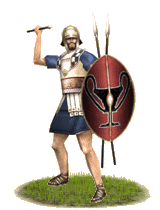 The Peltastai is a type of elite skirmisher that sacrifices heavy arms and armor for mobility and range. They are armored in linen and carry a medium sized ovular shield. Originally, they carried a crescent shaped 'pelta' shield, originated in Thrake and gave the peltastai their name, but this was phased out in the fourth century. Their armaments consist of several javelins and a sword. This panoply makes them light and mobile, but still able to engage in melee after their javelins have been thrown. They are a versatile unit but one must remember that their primary arms are javelins, and they are not equipped to stand toe to toe with heavier infantry. Their role is one of speed, harassment, and critical flanking maneuvers. The Peltastai is a type of elite skirmisher that sacrifices heavy arms and armor for mobility and range. They are armored in linen and carry a medium sized ovular shield. Originally, they carried a crescent shaped 'pelta' shield, originated in Thrake and gave the peltastai their name, but this was phased out in the fourth century. Their armaments consist of several javelins and a sword. This panoply makes them light and mobile, but still able to engage in melee after their javelins have been thrown. They are a versatile unit but one must remember that their primary arms are javelins, and they are not equipped to stand toe to toe with heavier infantry. Their role is one of speed, harassment, and critical flanking maneuvers.
Historically, the peltastai were often hoplitai or pezhetairoi equipped to fight in the manner of a skirmisher. This meant that they were adept melee combatants as well as being deadly with their javelins. Peltastai were used to great effect on ancient battlefields but by 270 BC the thureophoros was becoming the dominant melee skirmisher and the peltastai were carrying more javelins and were used in a manner that was consistent with this. This was simply a matter of specialization, and it did not mean that peltastai would be any less effective if deployed correctly. Their light armament makes them extremely fast, but tends to be to their detriment in melee combat. They were mostly used in the role of supporting missile troops who charged in at the last moment, after they had spent all their javelins. The great Athenian general Iphikrates is credited with the invention of the peltast as a distinct unit, and it is he that first employed them in this manner to great effect against the heavier armored and better trained hoplitai of Sparte.
Ekdromoi Hoplitai (Greek Light Hoplites)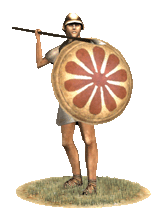 Ekdromoi Hoplitai are a specially equipped type of hoplites. They fight with little armor and no heavy equipment in order to be nimble enough to catch and kill skirmishers, especially peltastai, who became the bane of the heavily armored hoplites after they began to be used more extensively by Iphikrates. Their short spears carry a nasty punch for the lightly armed skirmishers and are able to outrange the better armored peltastai. They carry the large hoplon shield in order to make up for this disparity, but they are not meant to engage in prolonged melee combat with standard hoplites. Their light leather armor is soft and layered with bronze plates and cloth in order to retard the missiles of the troops that they would likely be fighting. Their purpose is to serve as a professional light infantry that can neutralize the effect of missiles on the heavy infantry. The combination of light armor and speed makes this infantry a great counter to the ever pesky missile troops. They are not particularly useful against heavier infantry or even equivalent light infantry, due to their specialized nature. Ekdromoi Hoplitai are a specially equipped type of hoplites. They fight with little armor and no heavy equipment in order to be nimble enough to catch and kill skirmishers, especially peltastai, who became the bane of the heavily armored hoplites after they began to be used more extensively by Iphikrates. Their short spears carry a nasty punch for the lightly armed skirmishers and are able to outrange the better armored peltastai. They carry the large hoplon shield in order to make up for this disparity, but they are not meant to engage in prolonged melee combat with standard hoplites. Their light leather armor is soft and layered with bronze plates and cloth in order to retard the missiles of the troops that they would likely be fighting. Their purpose is to serve as a professional light infantry that can neutralize the effect of missiles on the heavy infantry. The combination of light armor and speed makes this infantry a great counter to the ever pesky missile troops. They are not particularly useful against heavier infantry or even equivalent light infantry, due to their specialized nature.
These Hoplitai evolved in response to large scale use of peltastai by Thebai and Athenai after the reforms of Iphikrates. Their armor evolved as well, over the years. They were originally armored with linen, but this was changed due to the fact that the linothorax was vulnerable to missile fire. The layered leather was developed after a period of trial and error, and functions much like modern tank armor does against projectiles. It intersperses hard and soft layers to dissipate the effect of missile weapons. This armor, while exceedingly useful against missiles, is only marginally effective against most melee weapons, due to its lightness and the concentrated force of the arm behind the melee weapon. Once the initial force of a missile weapon is dissipated it falls away harmlessly, but a melee weapon's force doesn't dissipate as radically as a missile weapon's, since a missile weapon has a large amount of force propelling it, but that force is applied when the projectile is launched and it receives no more force after it is launched, while a melee weapon is given steady pressure that is much harder to dissipate.
Thureophoroi (Hellenic Spearmen) Thureophoroi were a new class of Hellenic infantry that was designed to both augment the phalanx and provide a type of soldier in between the phalangite and the peltastai that was able to both skirmish and fight in melee effectively. These men provide an extremely mobile force that can hit hard with their heavy javelins then rush in to flank pike units. They are well armed and armored for the task, having stout bronze helms, linen armor, an almond shaped thureos shield, heavy javelins, and a stout spear. They are highly versatile infantry, akin in spirit to the legionaries of Rome. They are a highly effective force of heavy infantry that is in the forefront of Hellenic military know-how. Thureophoroi were a new class of Hellenic infantry that was designed to both augment the phalanx and provide a type of soldier in between the phalangite and the peltastai that was able to both skirmish and fight in melee effectively. These men provide an extremely mobile force that can hit hard with their heavy javelins then rush in to flank pike units. They are well armed and armored for the task, having stout bronze helms, linen armor, an almond shaped thureos shield, heavy javelins, and a stout spear. They are highly versatile infantry, akin in spirit to the legionaries of Rome. They are a highly effective force of heavy infantry that is in the forefront of Hellenic military know-how.
Historically, Thureophoroi were used as harassing and flanking troops by the successor states. Though they were often described by Latin writers as copies of the legion, it is debatable whether they were developed with knowledge of warfare in Italy or not. Most Thureophoroi were Pezhetairoi, middle class property owners with voting rights, and as such, they were well able to devote time to training and practice and were highly disciplined and courageous troops. Despite their obvious advantages, or perhaps because of them, there was a lot of confusion as to how to utilize these new soldiers. As were deadly in the extreme to the less mobile phalanx units they forced a, much resisted, revaluation of Hellenic warfare. Perhaps for this reason the Diodachoi tended to used them conservatively, except for the Seleukidai, who took to these new soldiers quite well. The city-states of Hellas used them even more frequently against the armies of Makedonia, and were often able to hold the more powerful kingdom at bay. Still, their uses were limited in scope and not as widespread as their versatile and deadly role would have indicated. This is the fault of period commanders, however, and a more astute or innovative commander might have realized their potential in conjunction with the more static phalanx.
Thorakitai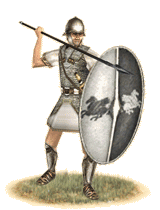 The Thorakitai represent the second evolution of the concept of the Theurophoroi, and show definite influence by the Romaioi in their implementation. They are armored in mail and carry heavy javelins instead of the lighter javelins carried by the Thureophoroi. They are more expensive and less mobile than their more lightly armored companions, but make excellent shock troops for any Hellenic army. They are best utilized on the flanks of the phalanx to either flank the enemy while the phalanx pins them, or prevent enemy flankers from attacking the phalanx's vulnerable flanks. They are best used in combination with the lighter Thureophoroi, who can support them with extra javelins and more importantly, speed, to make sure they are not surrounded. The Thorakitai represent the second evolution of the concept of the Theurophoroi, and show definite influence by the Romaioi in their implementation. They are armored in mail and carry heavy javelins instead of the lighter javelins carried by the Thureophoroi. They are more expensive and less mobile than their more lightly armored companions, but make excellent shock troops for any Hellenic army. They are best utilized on the flanks of the phalanx to either flank the enemy while the phalanx pins them, or prevent enemy flankers from attacking the phalanx's vulnerable flanks. They are best used in combination with the lighter Thureophoroi, who can support them with extra javelins and more importantly, speed, to make sure they are not surrounded.
Historically, the Thorakitai were used much like the Thureophoroi, but more rarely and later on. They were expensive soldiers, and one had to be fairly wealthy to equip one's self as a Thorakites. They were only used in any real numbers by the Seleukidai and the city-states of Hellas. They were never used to their full potential until the Romaioi raised legions in Hellas, and the type of fighting practiced by the Romaioi Legions and Thorakitai became the norm rather than the exception.
Hippeis (Greek Medium Cavalry) Hellene cavalry is not the most awe inspiring and powerful in the world, but nothing to be scoffed at either. Hippeis are a mix of good old fashioned Hellene know-how with the practical needs for an effective medium cavalry force. The result is the wedding of linen armor, Attik helmets, and hoplon shields to cavalry spears and the xiphos producing a warrior with excellent all-round equipment. Since they are mainly drawn from elite nobility, these cavalrymen have high morale and good discipline. They ride stout horses whose stock was imported from the north. They are an able, if not spectacular, medium cavalry. Hellene cavalry is not the most awe inspiring and powerful in the world, but nothing to be scoffed at either. Hippeis are a mix of good old fashioned Hellene know-how with the practical needs for an effective medium cavalry force. The result is the wedding of linen armor, Attik helmets, and hoplon shields to cavalry spears and the xiphos producing a warrior with excellent all-round equipment. Since they are mainly drawn from elite nobility, these cavalrymen have high morale and good discipline. They ride stout horses whose stock was imported from the north. They are an able, if not spectacular, medium cavalry.
Historically, Hellene cavalry was always thought of as better than Romaios cavalry, even though it was not particularly significant. The Hellenes have enough trouble keeping the equestrian Makedonians to the north at bay without having to worry about doing much of significance.
Prodromoi (Successor Medium Cavalry)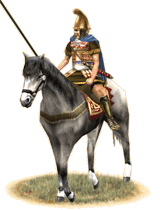 Prodromoi are the lightest of the Diadochoi melee cavalry and can be counted upon as superb flanking, raiding, and screening cavalry. They are well trained for light cavalry, but are still lightly armed and armored. They are not meant to be used as shock cavalry and will not roll up an enemy battle line in a thunderous charge, but instead make viable flanking cavalry which can quickly provide support where it is needed and be used to counter light missile troops of both the foot and mounted varieties. Their spears, shields, and linen armor give them some staying power, but they should not be used to in protracted melee for any great amount of time. Prodromoi are the lightest of the Diadochoi melee cavalry and can be counted upon as superb flanking, raiding, and screening cavalry. They are well trained for light cavalry, but are still lightly armed and armored. They are not meant to be used as shock cavalry and will not roll up an enemy battle line in a thunderous charge, but instead make viable flanking cavalry which can quickly provide support where it is needed and be used to counter light missile troops of both the foot and mounted varieties. Their spears, shields, and linen armor give them some staying power, but they should not be used to in protracted melee for any great amount of time.
Historically, the Seleukidai and Makedones used the smaller and weaker members of the nobility to form a quick and powerful light cavalry force that could decide an engagement on its own. Since these men are nobles, they have good staying power, as was evidenced by their widespread use in many battles. They are quick, and can be used to chase down missile cavalry when there is a need, due to the fact that they ride fast Thessalian horses and are relatively slight statured men. The Seleukidai use them as an effective counter to the Parthoi horse archers, much like the Hungarians of a later era did against the Turks.
Iphikratous Hoplitai (Greek Hoplite Phalanx)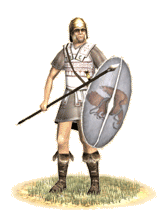 The hoplite went through a technological revolution from the time of the Peloponnesian War right until about 250 BC. Gone were the old hoplon shield and metal cuirass; gone were the short spears and crested helmets. These men were equipped with the latest in Hellenic technological innovation. Longer spears, linen and leather armor, lighter shields, boots, and Attic style helmets were the order of the day. This equipment put the hoplite on a par with his Makedonian rival to the north and made him lighter and quicker. These men are the quintessential heavy spear phalanx of the post-Peloponnesian era, and should be utilized in such a fashion. They are mobile and less tactically rigid than their Makedonian counterpart (whose primary job is to tie up the enemy infantry). They're hard hitting and well able to engage in melee with their shorter xiphos swords if the phalanx is disrupted. They're still vulnerable to flanking attacks and to missile troops, but are on a par with the Diadochoi's troops as a unit. The hoplite went through a technological revolution from the time of the Peloponnesian War right until about 250 BC. Gone were the old hoplon shield and metal cuirass; gone were the short spears and crested helmets. These men were equipped with the latest in Hellenic technological innovation. Longer spears, linen and leather armor, lighter shields, boots, and Attic style helmets were the order of the day. This equipment put the hoplite on a par with his Makedonian rival to the north and made him lighter and quicker. These men are the quintessential heavy spear phalanx of the post-Peloponnesian era, and should be utilized in such a fashion. They are mobile and less tactically rigid than their Makedonian counterpart (whose primary job is to tie up the enemy infantry). They're hard hitting and well able to engage in melee with their shorter xiphos swords if the phalanx is disrupted. They're still vulnerable to flanking attacks and to missile troops, but are on a par with the Diadochoi's troops as a unit.
Historically, the reforms of Iphikrates are the most notable in the series of innovations that befell the Hellenes, though they weren't as readily embraced until after the Makedonian phalanx proved the traditional hoplites obsolete. Prior to that, even Athenai and Thebai - who were the least reluctant to accept the changes - were not eager to accept the changes and didn't begin to field the newer hoplitai in very large numbers. Some poleis such as Sparte refused to accept the new equipment, and Spartiatai Hoplitai to this day use more conservative armaments. During the long series of internecine squabbles with Hellenistic powers and one another, the Hellenic cities had a great deal of trouble dealing with enemy mobile troops. This is offset somewhat by their equipment. Iphikrates himself can be reasonably credited with the adoption of a smaller shield, a longer spear, a better sword, and lighter armor. The helmet came later, at around 350 BC, followed by a further lengthening of the spear and adoption of the small theuros shield after the Galatiai incursions. Boots were adopted by the Hellenes around 300 BC and the final lengthening of the spear (to better fight the Makedones) happened near 280 BC. Numbers of individual armies dwindled due to infighting and constant mercenary activity.
Toxotai Kretikoi (Cretan Archers)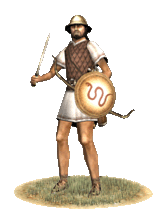 The island of Crete is renown for it's archers, and Cretans renown for their reputation as liars and brigands. These men hire themselves out as mercenaries for almost any Mediterranean power who can afford them, as their skills are often unmatched by other archers. Apart from their bow, they also have short swords and they wear hardened linen armor and carry a small shield. Not only are the Cretans good archers, but they can also fare well in melee, although against similarily equipped opponents. The island of Crete is renown for it's archers, and Cretans renown for their reputation as liars and brigands. These men hire themselves out as mercenaries for almost any Mediterranean power who can afford them, as their skills are often unmatched by other archers. Apart from their bow, they also have short swords and they wear hardened linen armor and carry a small shield. Not only are the Cretans good archers, but they can also fare well in melee, although against similarily equipped opponents.
Historically, Toxotai Kretikoi served in most Hellenic armies and other Mediterranean armies from early history, from Carthage in the west to the Seleukids in the east. One of their most famous exploits was in Xenophon's "Ten Thousand", where they gave a good account of themselves against the Persians. Crete during this time was rife with civil wars, and it was often those Cretans on the losing side or who get fed up with the unstable situation, who migrated overseas and hired themselves out as mercenary bowmen. The Diadochoi tried to gain control of the island, but were unsuccesful in their attempts. The constant civil wars attracted outlaws and other unwantables to Crete, that during the Hellenistic period bad behaviour was called "Cretan Way" and during the 1st century BC, the Cilician pirates established themselves on Crete and many Cretans joined them in piracy, which drew the ire of Rome. The first Roman expedition in 74 BC was soundly defeated, but the second expedition in 68 BC managed with great brutality to subjugate the island, which was afterwards made into a military colony, who for centuries to come supplied the Roman army with auxiliary archers, and their renown continued well into the Middle Ages. There is even distinct mention of Cretan archers defending Constantinople in 1453 AD!!
Hippeis Xystophoroi (Greek Noble Cavalry) The Hellene Hippeis Xystophoroi follows the practical need of a heavy cavalry to counter that of the hostile Makedonian neighbor. While not quite as well trained or lethal as the Makedonian heavy cavalry, they are still a battle-winning component of any army. They are armored in a bronze cuirass, helmet, and greaves and carry the deadly xyston lances and kopis swords. They should be used as any heavy cavalry should be, as a shock force to hit and roll up enemy flanks. Though they well suited for the job, they still lack the Úlan and martial prowess of the Hetairoi that the Diadochoi posses. The Hellene Hippeis Xystophoroi follows the practical need of a heavy cavalry to counter that of the hostile Makedonian neighbor. While not quite as well trained or lethal as the Makedonian heavy cavalry, they are still a battle-winning component of any army. They are armored in a bronze cuirass, helmet, and greaves and carry the deadly xyston lances and kopis swords. They should be used as any heavy cavalry should be, as a shock force to hit and roll up enemy flanks. Though they well suited for the job, they still lack the Úlan and martial prowess of the Hetairoi that the Diadochoi posses.
Historically, the Hippeis Xystophoroi were a small, elite group of noblemen that were used in much the same way as the Makedonian Hetairoi. They were never large in number, but served mainly to check the movements of other heavy cavalry and to hit the flanks of enemy soldiers. They were not used to any major effect, which is testament to their utility. They performed their tasks well enough to be deployed on the battlefield, yet not exemplarily enough to be used in a role that might not be fitting to men of their training and stature.
Koinon Hellenon Phalangitai (Greek Pikemen)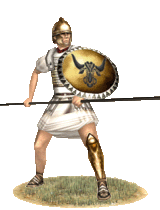 Stratege, while the Hellenes pride themselves in their hoplite tradition, and while much in warfare is still the same, much has also changed. The great pike formations of the Diadochoi, thousands of men armed in the Makedonian manner, with their rows of sarissa, offer a different sort of approach to battle than that which we have long embraced. It is one we have seen work, as at times we ourselves, and many times more our common enemies, have wasted our energies in a futile attempt to break through rank after rank of spear points. Having seen the success of soldiers armed in the Makedonian manner, some Hellenic poleis and leagues have begun to drill some of their soldiery in this formation, reasoning that such a development was a necessary precondition to competing with and defeating the Makedonian armies. Armed with an Attic helmet, a linothorax, greaves, and the round Makedonian pelte, these soldiers have been trained to fight as their cousins in the Diadochoi armies fight. They are not so fierce in the charge as our Hoplitai, and are even more unwieldy in maneuvers on the field, but their phalanx, if kept safe on the flanks, is nearly impenetrable. Stratege, while the Hellenes pride themselves in their hoplite tradition, and while much in warfare is still the same, much has also changed. The great pike formations of the Diadochoi, thousands of men armed in the Makedonian manner, with their rows of sarissa, offer a different sort of approach to battle than that which we have long embraced. It is one we have seen work, as at times we ourselves, and many times more our common enemies, have wasted our energies in a futile attempt to break through rank after rank of spear points. Having seen the success of soldiers armed in the Makedonian manner, some Hellenic poleis and leagues have begun to drill some of their soldiery in this formation, reasoning that such a development was a necessary precondition to competing with and defeating the Makedonian armies. Armed with an Attic helmet, a linothorax, greaves, and the round Makedonian pelte, these soldiers have been trained to fight as their cousins in the Diadochoi armies fight. They are not so fierce in the charge as our Hoplitai, and are even more unwieldy in maneuvers on the field, but their phalanx, if kept safe on the flanks, is nearly impenetrable.
Historically, a number of Hellenic states began experimenting with the Makedonian pike phalanx over the course of the third century. The third century was a time of development in many respects among the Hellenic leagues and poleis: the advent of Thureophoroi and Thorakitai came not long before the Phalangitai appeared on the Hellenic side on battlefields. Even states with long and fierce hoplite traditions, like the Spartans, eventually developed elements in their armies who fought in the Makedonian manner. In most cases, these soldiers came from the middle classes of the polis, or in the case of the Spartans, from the perioikoi and were trained by ex-mercenaries, many of whom had formerly served in the phalanxes of the Successor armies, or had at least observed their drill.
Thorakitai Hoplitai (Greek Heavy Hoplite Phalanx)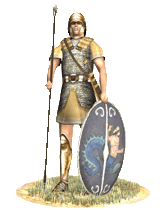 Some Hoplitai were able to afford better equipment and devote more time to warfare. Much of their equipment is similar to the less wealthy Hoplitai, with one exception. They were often armored in mail, which gave them better protection against most weapons in relation to the linothorax and leather used by other Hoplitai. The Thorakitai Hoplitai are among the best infantry in the world, if tactically inflexible due to the slowness of movement of an armored phalanx. Some Hoplitai were able to afford better equipment and devote more time to warfare. Much of their equipment is similar to the less wealthy Hoplitai, with one exception. They were often armored in mail, which gave them better protection against most weapons in relation to the linothorax and leather used by other Hoplitai. The Thorakitai Hoplitai are among the best infantry in the world, if tactically inflexible due to the slowness of movement of an armored phalanx.
Historically, the Thorakitai Hoplitai (heavy hoplites) were the elite of most Hellenic armies, and tended to make up only a small percentage of the forces in the army. They were often deployed on the right flank of a Hellenic phalanx because the right side was more vulnerable than the left in phalanx combat. A hoplite was armed with his shield on his left arm and his spear gripped in his right one. Because of this the left side of a phalanx formation was naturally less vulnerable and the best soldiers were placed on the right flank with the logic being that elite troops would fight longer in dangerous situations than green or more poorly equipped soldiers. The Thorakitai Hoplitai were mostly grizzled mercenary veterans who had amassed enough wealth for higher quality panoplia or wealthy citizens who had a penchant for warfare. They were almost never used against the Romaioi because the Hellenikai poleis mainly accepted Romaios hegemony without serious struggle. The exception was Korinthos, whose Thorakitai Hoplitai broke the Romaioi left flank during the battle for the city, but were checked and then promptly cut down by Romaioi legionaries and Noumidoi mercenaries enveloping them on three sides.
Epilektoi Hoplitai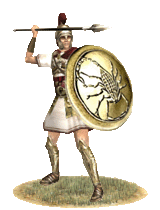 Hail Stratege! Your finest warriors, the true elite of the polis, stand here before you. They are drawn from the bravest and wealthiest men. They eschew the horse, preferring to allow their brothers who are too cowardly to fight on foot the role of cavalry. They are armored in the finest bronze armor, with shields made from only the best and stoutest wood. These shields are faced with fine leather or bronze, and in the skilled hands of your greatest soldiers, they can stop all but the most determined blows. The spears of these fine soldiers are made from the best cornel wood and iron. All of them are battle tested veterans. None will shirk from the shield wall and the killing, for each regards it with the cold dispassion of an elite soldier that belies their name: the Epilektoi, or picked ones. Hail Stratege! Your finest warriors, the true elite of the polis, stand here before you. They are drawn from the bravest and wealthiest men. They eschew the horse, preferring to allow their brothers who are too cowardly to fight on foot the role of cavalry. They are armored in the finest bronze armor, with shields made from only the best and stoutest wood. These shields are faced with fine leather or bronze, and in the skilled hands of your greatest soldiers, they can stop all but the most determined blows. The spears of these fine soldiers are made from the best cornel wood and iron. All of them are battle tested veterans. None will shirk from the shield wall and the killing, for each regards it with the cold dispassion of an elite soldier that belies their name: the Epilektoi, or picked ones.
Historically, the Greek poleis fielded small numbers of extremely hardened and well armed warriors. These soldiers were every bit the match of the elite units of other nations, as proven in engagement after engagement. They are best used where the decisive action will take place, either to force their way through enemy infantry, or to repulse the heavy cavalry of the other Greek states.
Spartiatai Hoplitai (Spartan Hoplites)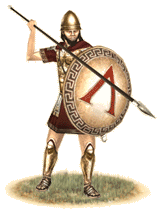 The Spartans are the greatest warriors in the entire world, or so they think, anyway. Spartan youths are trained from birth to be soldiers, and as such are ferocious fighters that often fight to the last man. They have extremely high morale and discipline, and are armed and armored more conservatively than most other Greek hoplites. Spartans still use the hoplon, but have shifted to the pilos helmet and muscled cuirass. They still use the traditional spear of the Greek hoplite to great effect. Spartans can punch a hole through almost any line, and fight extremely well with their overhand spears. They are elite, and as their description implies, very expensive and time consuming to train. Though their tactics are somewhat anachronistic, their fighting spirit leaves little doubt that they are still a formidable force. The Spartans are the greatest warriors in the entire world, or so they think, anyway. Spartan youths are trained from birth to be soldiers, and as such are ferocious fighters that often fight to the last man. They have extremely high morale and discipline, and are armed and armored more conservatively than most other Greek hoplites. Spartans still use the hoplon, but have shifted to the pilos helmet and muscled cuirass. They still use the traditional spear of the Greek hoplite to great effect. Spartans can punch a hole through almost any line, and fight extremely well with their overhand spears. They are elite, and as their description implies, very expensive and time consuming to train. Though their tactics are somewhat anachronistic, their fighting spirit leaves little doubt that they are still a formidable force.
Historically, Sparta was the first experiment in what we might recognize today as militarized National Socialism. Their boys were taken from the parents as soon as they were able to walk and trained to be soldiers. They were often beaten and generally mistreated by their teachers until they reached an age where they could fight back. They engaged in heavy physical activity from an early age, exercising and practicing to fight almost as a religion. They were encouraged to steal and be crafty to survive, but were often beaten if caught. There are even some accounts of required sodomy between the young boys and sometimes even wife sharing, with the belief that a military unit should even love together! In this harsh environment, tough and fanatical soldiers are produced. When the Spartans were finally defeated and subjugated by the Romans, one of the more conservative Roman nobles is said to have wept and lamented the passing of a warrior culture without equal. The Spartan mantra is: march back in triumph with your shield, or be brought back lying upon it.
Sphendonetai Rhodioi (Rhodian Slingers)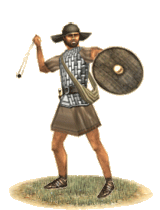 These men hail from Rhodos, one of the most storied states and greatest mercantile powers in the Hellenistic world, famous for its fine slingers throughout the Classical and Hellenistic periods. Men like these traveled with Xenophon, fought in the armies of Phillip and Alexander, and served as mercenaries with most of the major powers even through Roman domination. They are armed with slings made from leather, as well as hemp and flaxen cord, and are armored in a padded linen 'half-cuirass'. This gives them some longevity in melee combat, but they are best withdrawn before melee begins in earnest. Their missiles will rain death upon most foes, and they out-range most enemies.
These men hail from Rhodos, one of the most storied states and greatest mercantile powers in the Hellenistic world, famous for its fine slingers throughout the Classical and Hellenistic periods. Men like these traveled with Xenophon, fought in the armies of Phillip and Alexander, and served as mercenaries with most of the major powers even through Roman domination. They are armed with slings made from leather, as well as hemp and flaxen cord, and are armored in a padded linen 'half-cuirass'. This gives them some longevity in melee combat, but they are best withdrawn before melee begins in earnest. Their missiles will rain death upon most foes, and they out-range most enemies.
Historically, slingers from Rhodes and others trained in their methods made significant contributions to Hellenic and Successor armies. Xenophon's Anabasis is probably the clearest example, where slingers from Rhodos are able to outfight archers and presumably keep mounted archers at bay. They performed the latter function for Alexander as well, in concert with bolt-throwing engines. In the acceding Hellenistic age, their use by virtually every power is a testament to their effectiveness. Slingers from Rhodos appear later in the Roman army, but history from later periods becomes increasingly sketchy.
Somatophylakes Strategou (Greek General) Hail Arche! Your finest warriors, the true elite of the polis, stand here before you. They are drawn from the bravest and wealthiest men. They eschew the horse, preferring to allow their brothers who are too cowardly to fight on foot the role of cavalry. They are armored in the finest bronze armor, with shields made from only the best and stoutest wood. These shields are faced with fine leather or bronze, and in the skilled hands of your greatest soldiers, they can stop all but the most determined blows. The spears of these fine soldiers are made from the best cornel wood and iron. All of them are battle tested veterans. None will shirk from the shield wall and the killing, for each regards it with the cold dispassion of an elite soldier that belies their name: the Epilektoi, or picked ones. Hail Arche! Your finest warriors, the true elite of the polis, stand here before you. They are drawn from the bravest and wealthiest men. They eschew the horse, preferring to allow their brothers who are too cowardly to fight on foot the role of cavalry. They are armored in the finest bronze armor, with shields made from only the best and stoutest wood. These shields are faced with fine leather or bronze, and in the skilled hands of your greatest soldiers, they can stop all but the most determined blows. The spears of these fine soldiers are made from the best cornel wood and iron. All of them are battle tested veterans. None will shirk from the shield wall and the killing, for each regards it with the cold dispassion of an elite soldier that belies their name: the Epilektoi, or picked ones.
Historically, the Greek poleis fielded small numbers of extremely hardened and well armed warriors. These soldiers were every bit the match of the elite units of other nations, as proven in engagement after engagement. They are best used where the decisive action will take place, either to force their way through enemy infantry, or to repulse the heavy cavalry of the other Greek states.
|
 |
|
 |






















|